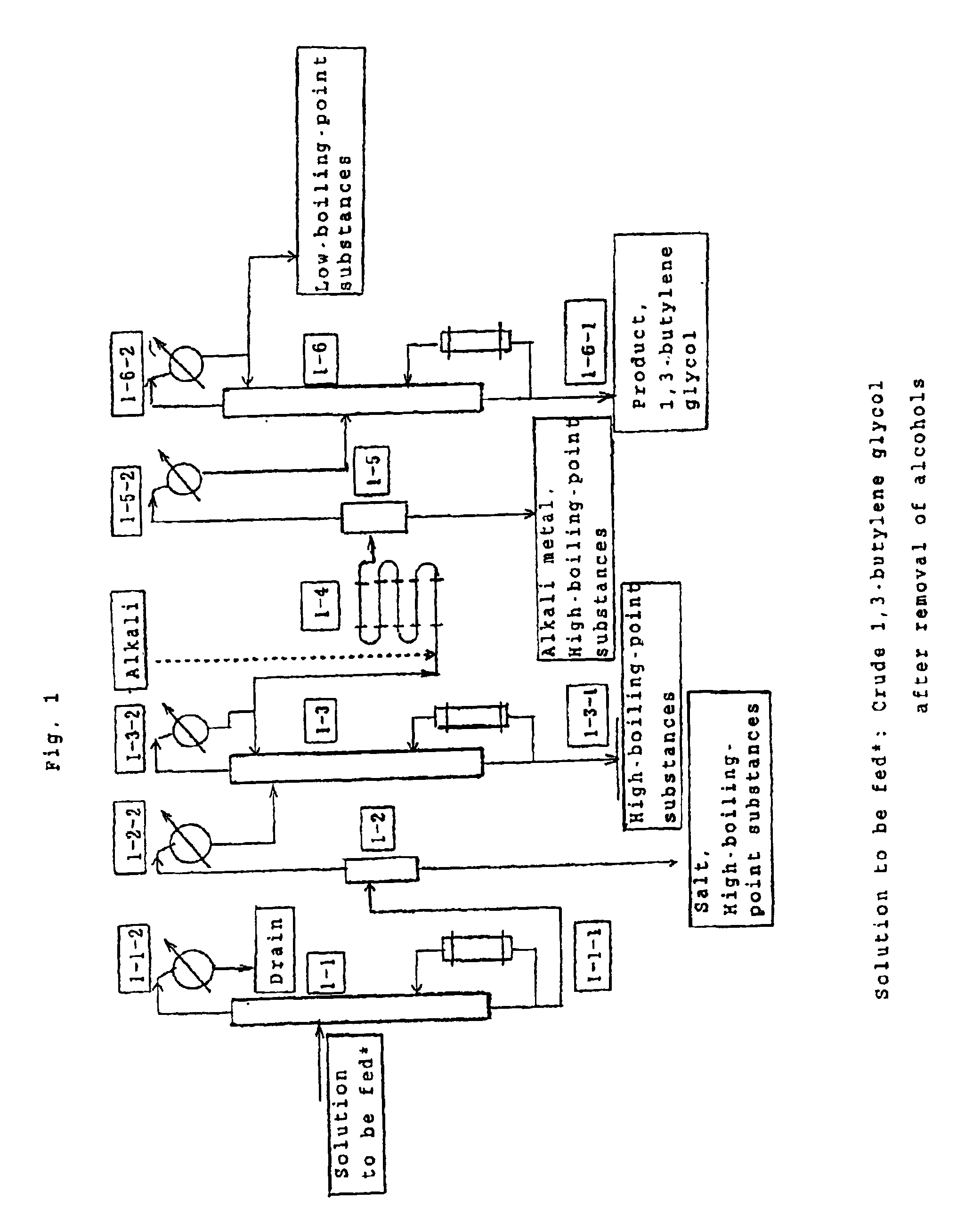High-purity 1,3-butylen glycol, process for producing 1,3-butylene glycol, and process for producing by-product butanol and butyl acetate
a technology of 1,3-butylene glycol and process, which is applied in the field of high-purity 1,3-butylene glycol, process for producing 1,3-butylene glycol, and process for producing by-product butanol and butyl acetate, etc., can solve the problems of process (ii) not practical, process (iii) not practical, and difficult long-term storage of butylene glycol
- Summary
- Abstract
- Description
- Claims
- Application Information
AI Technical Summary
Benefits of technology
Problems solved by technology
Method used
Image
Examples
examples
Examples for the First Invention Group
[0216]The inventions of the first invention group will be next described in more detail by way of Examples, which should not be construed as limiting the inventions thereto. It is to be noted that unless otherwise specified, the term “part(s)” used in the Examples refers to “part(s) by weight.” The below-described evaluation methods were employed.
[0217]1. Potassium permanganate color-fading time (may be referred to as “chameleon test measurement value”): the time is measured according to JIS K1351 3.10 (unit: minute)
[0218]2. Odor evaluation rating: rating “1” is assigned to 1,3-butylene glycol which issues no odor, rating “5” is assigned to 1,3-butylene glycol which issues minimal odor, rating “10” is assigned to 1,3-butylene glycol which issues a slight odor, and rating of an evaluation sample (i.e., 1,3-butylene glycol) is determined on the basis of the results of relative evaluation. Odor evaluation was performed as follows. An evaluation sam...
examples 1-1 and 1-2
[0220]The process of the first invention group will be described by way of Examples and with reference to the flowsheet shown in FIG. 1. Acetaldol (100 parts) and hydrogen (6.5 parts) serving as raw materials were placed in a reactor (not illustrated in the FIG. 1) The reactor was maintained at a temperature of 125-135° C. and a pressure of 150 Kg / cm2. A Raney nickel (3.5 parts) serving as a catalyst was added to the reactor. A crude reaction mixture was removed from the reactor, the catalyst was separated from the mixture, and the resultant mixture was neutralized with sodium hydroxide. Subsequently, alcohols were removed from the neutralized mixture, and the resultant crude 1,3-butylene glycol was fed into a dehydration tower 1-1 shown in FIG. 1. Through the top of the dehydration tower, water (15 parts) was added with respect to the fed solution (100 parts), dehydration was carried out at a pressure of 50 torr, and a crude 1,3-butylene glycol containing water in an amount of 0.5%...
example 2-1
[0229]A para-acetaldol reaction mixture was obtained through condensation of acetaldehyde in the presence of a sodium hydroxide aqueous solution, and neutralization of the reaction mixture was carried out. A portion of unreacted acetaldehyde was recovered from the neutralized mixture, and the resultant crude reaction mixture was fed into a continuous suspension bubble tower in which a Raney nickel having the below-described properties was suspended in the mixture. Subsequently, hydrogenation was carried out under the below-described conditions, the Raney nickel was removed through filtration, and a hydrogenation crude mixture was obtained.
[0230]The Raney nickel contains nickel in an amount of 49% by weight during alloying, and it showed a grain size distribution of (grains having a size of more than 74 μm (3.3%), grains having a size of 43 μm to 74 μm (17.4%), and grains having a size of 43 μm or less (79.2%)). After development, the Raney nickel contains aluminum in an amount of 8%...
PUM
| Property | Measurement | Unit |
|---|---|---|
| Weight | aaaaa | aaaaa |
| Time | aaaaa | aaaaa |
| Percent by mass | aaaaa | aaaaa |
Abstract
Description
Claims
Application Information
 Login to View More
Login to View More - R&D
- Intellectual Property
- Life Sciences
- Materials
- Tech Scout
- Unparalleled Data Quality
- Higher Quality Content
- 60% Fewer Hallucinations
Browse by: Latest US Patents, China's latest patents, Technical Efficacy Thesaurus, Application Domain, Technology Topic, Popular Technical Reports.
© 2025 PatSnap. All rights reserved.Legal|Privacy policy|Modern Slavery Act Transparency Statement|Sitemap|About US| Contact US: help@patsnap.com

